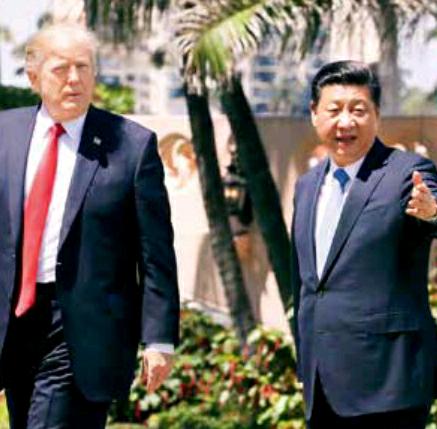China-U.S.Relations Today and Tomorrow
by+He+Fan,Zhu+He+and+Ye+Qianlin
From November 8 to 10, 2017, U.S. President Donald Trump made a state visit to China. The historic meeting of the two countriesheads of state resulted in strategic guidelines for developing healthy bilateral economic and trade relations as well as a direction and plan for further strengthening bilateral win-win cooperation, making it an important event to promote stable development of ChinaU.S. ties in the new era.
Since the two countries established diplomatic relations in 1979, China and the U.S. have managed to maintain shared benefits and good momentum, for the most part. Now, in a totally different era, China-U.S. relations are also entering a new stage, making it necessary to redefine their new type of major-country relations and realign their economic and trade cooperation.
New World Context
China-U.S. relations are surrounded by an entirely new world context. In terms of economic growth, the global economy still has not completely emerged from the shadow of the 2008 international financial crisis. In particu- lar, some developed countries remain stuck in an economic slump, which has resulted in considerable social conflict. The U.S. economy is also facing some challenges, while China has become the worlds second largest economy after decades of rapid economic growth.
Geopolitical conflict has increased worldwide, demanding an upgrade of the traditional global security network to satisfy needs for public safety and stability. The rise of ISIS headlined the spread of terrorism around the world, and Europe has suffered several attacks. The Syrian crisis caused a flood of refugees to Europe, which has intensified divisions already encumbering the continent.
The domestic political situations in China and the U.S. alike are comparatively stable. And the interests of the two countries have gradually shifted. The 19th National Congress of the Communist Party of China designed a strong theoretical system concerning the countrys politics, economics, culture and national defense, which looks promising for future China-U.S. relations. Since Donald Trump took office this January, the stability, policy continuity and predictability of China-U.S. strategic relations have been better than expected. The domestic politics of the U.S. requires stable China-U.S. ties to a great extent.endprint

Major-Country Relations
Economic strength plays an important role in major-country relations. Over the past several decades, thanks to the countrys demographic dividend and late-mover advantage, the Chinese economy has grown rapidly. In 2009 and 2010, China successively surpassed Germany and the U.S. to become the worlds largest exporter and manufacturer.
Economically, the U.S. remains a superpower and a leader of the global financial and monetary system. American fund managers operate 55 percent of global assets, Wall Street controls half of the worlds market value and nearly half of bonds issued worldwide are denominated in U.S. dollars.
Technologically, the U.S. is top in the world. By August 2017, the market value of Apple, Microsoft, Facebook and Amazon, the five giants in Silicon Valley, amounted to nearly US$3 trillion, ranking fifth in the world if they were a combined economy. In the second quarter of this year, although Chinas Alibaba and Tencent squeezed into the worlds top ten companies, their collective market value was still lower than that of Apple.
Chinas demographic dividend is fading, which once contributed to narrowing the gap between China and the U.S. With a low birth rate, Chinas labor pool is drying up and its society is aging. In terms of technological innovation, China is still lagging behind the U.S., which hinders its industrial upgrade. Mainly driven by investment, Chinas economy still has a lot of room to improve compared to the diversified industrial structure and consumption-driven growth pattern of the U.S.
Economic and Trade Cooperation
For a long time, economic and trade cooperation served as the “anchor” for China-U.S. relations. Bilateral trade volume in 2016 was 211 times the figure it was in 1979. Especially after Chinas entry into the WTO in 2001, bilateral trade has boomed, making the two countries interests intertwined. With the massive volume of trade between the two countries, problems have emerged such as the U.S. trade deficit with China and disputes on RMB exchange rate. Considerable academic research shows that the trade deficit is primarily caused by the two countriesdivision of the global supply chain, industrial structures and saving rates.
China-U.S. relations for a new era need new ideas. The economic and trade frictions between the two countries should be solved with solutions beyond trade and economic realms. China and the U.S. need to raise bilateral relations to strategic heights and make comprehensive plans to improve their ties. The two nations need to explore new areas of cooperation and seize new opportunities for the development of bilateral relations. At the same time, the two countries need to attach more importance to new potential challenges emerging in fields like economics and security and set up an efficient mechanism for strategic communication and dialogue to avoid strategic miscalculations. endprint
endprint

